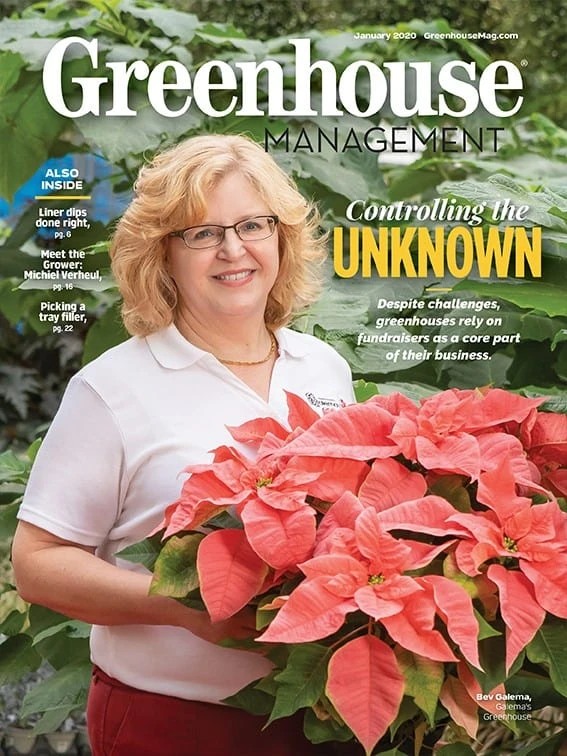

Fungus gnat adults (Bradysia spp.) are dark-bodied, slender, long-legged insects in the order Diptera. They are a common pest, especially in the moist growing environment in propagation greenhouses. Larvae feed upon the developing roots of cuttings and young plants.
Fungus gnat larvae feed upon young cuttings and plugs, causing root injury and plant wilting. Larvae can tunnel into plant crowns causing plant death. Larvae also create wounds that can allow the entry of soilborne pathogens. Fungus gnat adults and larvae may also spread soilborne plant pathogens such as Thielaviopsis, Phytophthora, Pythium and Fusarium.
Fungus gnat larvae are general plant feeders. Ornamental plants with succulent stems, such as begonias, geraniums, sedum, coleus and poinsettias, are especially prone to injury, especially if the growing media contains a high percentage of compost, composted bark or peat moss.


Scouting for fungus gnats
Use yellow sticky cards placed horizontally at the media surface to attract fungus gnat adults. Adult fungus gnats are small (1/8-inch-long), mosquito-like insects, with long legs and antennae. Their two wings are delicate and clear with a Y-shaped vein in the wing pattern. Check yellow sticky cards weekly.
Place potato chunks or plugs on the media surface to attract fungus gnat larvae. Check potato slices after two days for the larvae. Fungus gnat larvae are small, (approximately ¼ of an inch long when mature), translucent to white in color with a distinctive black head capsule. Inspect root systems for overall health and for signs of damage from fungus gnat feeding (i.e. blunt root tips).


Biological control options for fungus gnats
Fungus gnat larvae can be effectively managed using entomopathogenic or insect-killing nematodes, Steinernema feltiae (NemaShield, Nemasys, Scanmask, Entonem) that are applied as a preventive soil drench or sprench. They are best applied to moist soils, in the early morning or evening to avoid high temperatures and ultraviolet levels. Repeat applications every two weeks against fungus gnat larvae. Beneficial nematodes can be used alone, or in combination with other biological control agents. Growers just beginning to use biological control agents, often start with S. feltiae. This is because they work so well and can also be used in rotation with insecticides. Be sure to check with your biological control supplier for information on compatibility with insecticides and specific guidelines for application.
Soil-dwelling predatory mites (Stratiolaelaps scimitus, formerly known as Hypoaspis miles), predatory rove beetles (Dalotia coriaria) and entomopathogenic nematodes (Steinernema feltiae) can all be used in a preventive biological control program against fungus gnat larvae. The growing medium should be moist before applying these natural enemies. Although not commercially available, predatory hunter flies (Coenosia attenuate) may be introduced on incoming plant material. Biological controls are best used preventively combined with good cultural controls: avoiding overwatering, removing low-growing weeds and having a clean, dry greenhouse.
Insecticides that control fungus gnats
There are a number of insecticides available for use against fungus gnat larvae, which is the life stage to target. Repeated applications are often needed. Some materials include insect growth regulators: cyromazine (Citation) (MOA 17), azadirachtin (Azatin, Molt-X), pyriproxyfen (Distance) (MOA 7c) and diflubenzuron (Adept) (MOA 15). The microbial insecticide, Bacillus thuringiensis subsp. israelensis (Gnatrol WDG) (MOA 11A) works best against the young, first instar larvae. Chlorfenapyr (Pylon) (MOA13), dinotefuran (Safari) (MOA4A) or thiamethoxam (Flagship)(MOA4A) may also be options. Read labels carefully for plant safety precautions and follow resistance management guidelines.

Explore the January 2020 Issue
Check out more from this issue and find your next story to read.
Latest from Greenhouse Management
- Anthura acquires Bromelia assets from Corn. Bak in Netherlands
- Top 10 stories for National Poinsettia Day
- Langendoen Mechanical hosts open house to showcase new greenhouse build
- Conor Foy joins EHR's national sales team
- Pantone announces its 2026 Color of the Year
- Syngenta granted federal registration for Trefinti nematicide/fungicide in ornamental market
- A legacy of influence
- HILA 2025 video highlights: John Gaydos of Proven Winners





